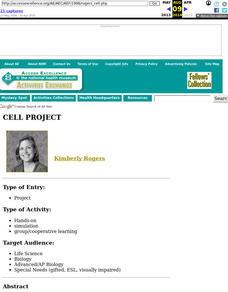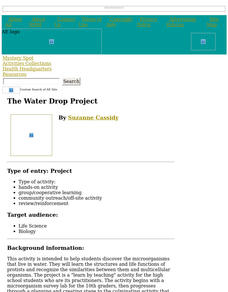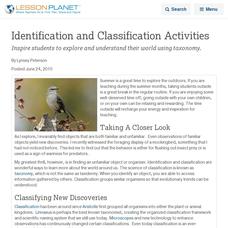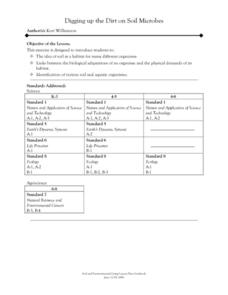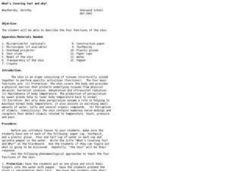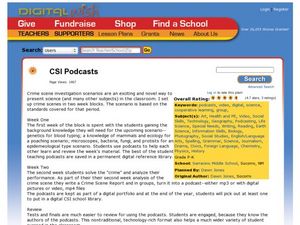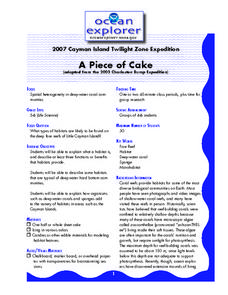Curated OER
The Science and Technology of Food
Students examine the guidelines the United States Department of Agriculture places on food. In groups, they create a list of the foods they consume and discuss the political and environmental implications of purchasing the food. They...
Curated OER
Chromosome Karyotyping
High schoolers explore chromosome karyotyping. In this chromosome karyotyping lesson plan, students use a chromosome kit to explore chromosome syndromes and disorders. They also produce a large model of a cell with chromosome to simulate...
Curated OER
Cell Project
Students investigate cells. They discover what cells are, where they are found, what they do and what they are made of. They construct a giant cell that is posted on the bulletin board.
Curated OER
The Water Drop Project
Students discover the microorganisms that live in water. They study the structures and life functions of protists and recognize the similarities between them and multicellular organisms.
Curated OER
Remote Sensing
Students study the effects of global warming on specific organisms. They research the possible problems global warming is causing.
Curated OER
Bridging the Gaps Between the Three Worlds of Chemistry
Young scholars examine the observed world, molecular world, and the symbolic world of chemistry. They observe a demonstration of the conductivity of solutions, describe the properties of acids and bases, and predict the outcome of...
Curated OER
Identification and Classification Activities
Explore and understand your world with taxonomy.
Curated OER
A Distant View
Learners investigate the essential concepts of how lenses work to magnify vision, and then build simple telescopes to demonstrate their understanding. They write a description of how their telescope could be improved and how it works.
Curated OER
Conduction, Convection, Radiation, Oh My!
Learners draw a line graph, and use graphing as a tool to discover more about conduction, convection and radiation. They should design their own experiment using heat sensitive paper to show they explain these 3 processes.
Michigan Sea Grant
Invasive Species
Learners identify invasive species to the Great Lakes and analyze their impact on the ecosystem. Using photo cards with pictures and facts, young scientists work in small groups to match invasive species with their corresponding...
Curated OER
Digging up the Dirt on Soil Microbes
Learners are introduced to the idea of soil as a habitat for many different organisms. They are introduced to the links between the biological adaptations of an organism and the physical demands of its habitat. Pupils are introduced to...
Curated OER
Digestible Computers
Students examine the pros and cons of 'embedded computing' in the field of medicine. They invent and describe a computer that would be embedded in an individual to improve their education or school and write essays critiquing their...
Curated OER
Ecological Succession in Pond Water Cultures
Students collect samples of pond water, dried grass, and soil in a jar. They predict the order of ecological succession in their pond water cultures. They compare their expected results with their observed results.
Curated OER
What's Covering You? and Why?
Students take a closer look at human skin. In this biology lesson plan, students describe the four functions of the skin as they complete a hands-on activity.
Curated OER
Comparison of Normal vs Mutant Zebra Fish Embryos
Young scholars observe and study mutations. In this mutations lesson, students work in groups to complete observation tables of various mutations of the zebra fish embryos. Groups give presentations about their observations.
Curated OER
Creating Coacervates
Students create and observe coacervates. In this origin of life lesson, students create coacervates by mixing carbohydrate and protein solutions. They observe the life-like qualities of the structures and discuss the origin of life.
Curated OER
CSI Podcasts
Learners investigate crime scene scenarios to meet standards. In this crime scene scenario lesson, students gather background information during the first week. They investigate topics such as mammals, genetics, bacteria, or fungi. They...
Curated OER
How do living and non-living structures affect coral reef habitats?
Students create model coral reefs showing surface area and including examples of communities. In this coral reef lesson, students research and explore the functions or benefits from a coral reef. Students design a benthic...
Curated OER
Stem Cells: 5 Year Progress Report
Young scholars explore different aspects of stem cells. In this human biology instructional activity, students complete numerous activities including reading an article and discussing it, watching a video on stem cells reproducing...
Curated OER
A Piece of Cake: Ocean Communities
Students explain habitats. In this model based lesson students create a model to help describe a habitat that is typical of deep-water. Students will describe how organisms such as coral and sponges add to their habitat.
Curated OER
What's Down There
Students write an essay about the coral reefs. For this oceanography lesson, students investigate the reef of Bonaire and compare it to reefs that are not thriving. Students then explore the differences that contribute to the overall...
Curated OER
Introduction to Ocean Grazers
Students explore biology by creating a poster with classmates. In this oceanography instructional activity, students identify the importance of coral reefs to the ocean's ecology and examine a food web of ocean animals. Students define a...
Curated OER
Case Study Two: Shark Dissection
Students read an article on sharks prior to beginning a dissection lab. As part of the lab, students identify differences between the shark anatomy and human anatomy and hypothesize why those differences exist.
Curated OER
Cells Are Us
Students explore cells. In this science lesson plan, students investigate how the cell is the basic unit of life, that cells divide slowly to become mass of cells, and that there is a gradual loss of cells throughout life.


